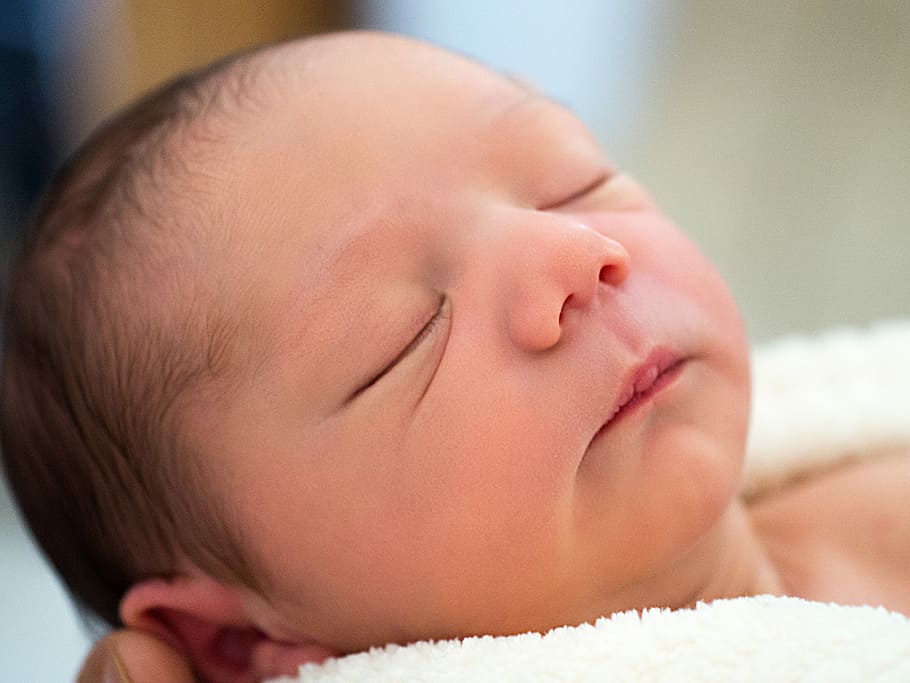 Infant sleep training refers to a number of different regimens parents employ to adjust their child’s sleep behaviors.
Infant sleep training refers to a number of different regimens parents employ to adjust their child’s sleep behaviors.
During the first year of life, infants spend most of their time in the sleeping state. Assessment of sleep during infancy presents an opportunity to study the impact of sleep on the maturation of the central nervous system (CNS), overall functioning, and future cognitive, psychomotor, and temperament development. Sleep is essential to human life and involves both physiologic and behavioral processes. Sleep is now understood as not simply a resting state, but a state that involves intense brain activity. The first year of life is a time of substantial change in the development of both the human brain physical and motor development. During this a time, which is about 0-12 months, the baby’s brain essentially doubles in size. However, an infant goes through several sleep regressions starting at 1 week, which can occur weekly or fortnightly, until 8 years of age.
The sleep-wake cycle is a daily sleep pattern consisting of 16 hours of daytime wakefulness and 8 hours of night-time sleep. The control of sleep and the sleep-wake cycle are regulated by the CNS so, the relationship between the CNS and the sleep-wake cycle is vital. Some of the hormones that govern the cycle come from the pituitary gland and have been found to be released episodically rather than continuously.
The long sustained sleep period (LSP) is the period of time that a child sleeps without awaking. The length of this period increases dramatically between the first and second months. Between the ages of three and twenty-one months, LSP plateaus, increasing on average only about 30 minutes. In contrast, a child’s longest self-regulated sleep period (LSRSP) is the period of time where a child, without sleep problems, is able to self-initiate sleep without parental intervention upon waking. This means the child can fall asleep without the help of their parents. This self-regulation, also called self-soothing, allows the child to consistently use these skills during the nocturnal period. LSRSP dramatically increases in length over the first four months, plateaus, and then steadily increases at nine months. By about six months, most infants can sleep eight hours or more at night uninterrupted or without parental intervention upon awaking.
A baby’s sleep schedule changes over time. Firstly, an infant from one to three months of age may sleep sixteen to eighteen hours a day in periods that last from three to four hours. By three months the period of sleep lengthens to about four or five hours, with a decrease in the total sleep time to about fourteen or fifteen hours. At three months, they also start to sleep when it is dark and wake when it is light. They have begun to sync their sleep clocks with the time of day. These clocks have also been referred to as “circadian rhythms” or “molecular clocks” in recent findings. Other findings also portray that certain genes known as circadian master genes have effects on sleep clocks. There are two distinct napping periods: mid-morning and late afternoon. Finally, by six months the longest LSP is six hours and occurs during the night. There are two three-or-more hour naps with a total average sleep time of fourteen hours.
Though sleep is a primarily biological process, it can be treated as a behavior. Thus sleep can be altered and managed through practice and can be learned by the child, similarly how adults can alter and manipulate it. Healthy sleep habits can be established during the first four months to lay a foundation for healthy sleep. In Western European culture and elsewhere, these habits typically include sleeping in a crib (instead of a car seat, stroller, or swing), being put down to sleep when drowsy but awake, and avoiding negative sleep associations, such as nursing to sleep or using a pacifier to fall asleep, habitual behaviors may be hard to break in the future.
Every child is different and each child’s sleep becomes regular at different ages within a particular range. In the first few months of life, each time the baby is laid down for bed and each time he or she awakens is an opportunity for the infant to learn sleep self-initiation and to fall asleep without excessive external help from their caregiver. Experts say that the ideal bedtime for an infant falls between 6 pm and 8 pm, with the ideal wake-up time falling between 6 am and 7 am. At four months of age, infants will typically take hour naps two to three times a day, with the third nap dropped by about nine months. By 9 months their sleep patterns normalize naturally. By one year of age, the amount of sleep that most infants get nightly approximates to that of adults.
It is important to have structure in the way a child is put to sleep so that he or she can establish good sleeping patterns. Sylvia Bell of Johns Hopkins University reported: by the end of the first year individual differences in crying reflect the history of maternal responsiveness rather than constitutional differences in infant irritability. She also notes: consistency and promptness of maternal response is associated with decline in frequency and duration of infant crying. When following through with this maternal response, Bell notes that it is most effective to apply physical contact with the infant. The sleep position is also important to prevent SIDS (Sudden Infant Death Syndrome).
A key debate in sleep training revolves around getting the right balance between parental soothing and teaching the baby to self-soothe. Some parents who practice attachment parenting think the parent should attend to the baby whenever he or she cries, and limit tears as much as possible. According to studies, sleep problems have been reported in 20 to 30 percent of infants, keeping parents awake. However, many popular sleep training methods, such as the Ferber Method, rely on letting the baby “cry it out” for a certain number of minutes, so that so-called “self-soothing” skills are fostered instead of an over-reliance upon externally-provided soothing. The Ferber method has been criticized by some for being cruel. Sleep scientists, some of whom profit from sleep training clinics[unbalanced opinion?], study isolated variables using “intent to treat” methodologies that leave one uncertain as to what participating families did, have not designed studies that look at child well-being variables nor lifelong effects. However, some psychologists say the sleep scientists are failing to take into account the subtle psychological effects of being left alone to cry yourself out; they say: “The fact is that caregivers who habitually respond to the needs of the baby before the baby gets distressed, preventing crying, are more likely to have children who are independent than the opposite. Soothing care is best from the outset. Once patterns of distress get established, it’s much harder to change them.” Developmental psychological research has demonstrated that emphasizing baby independence in the first year of life is correlated with insecure attachment, which leads to poor peer relations and more dependence later in childhood.
A few baby soothing techniques include bouncing, jiggling, rocking baby while sitting in a rocking chair, doing knee bends while holding them, doing comfort feeding, providing them with a pacifier, using a white noise machine or app, swaddling them, skin-to-skin contact, using a bouncer or swing to mechanically rock them, and more. Some parents reject the use of most or all baby soothing techniques under the idea that you should teach a baby to self-soothe. Other parents think having devices such as white noise machines and swings are crucial because they allow the parents to take breaks and get things done other than just holding their baby.
Another method is Behavioral Infant Sleep Intervention to effectively reduce infant sleep problems and associated maternal depression in the short- to medium-terms. This method randomized tried and found effective though, despite their effectiveness, theoretical concerns persist about long-term harm on children’s emotional development, stress regulation, mental health, and the child-parent relationship. This method proves to be causing no long-lasting harms or benefits to child, child-parent, or maternal outcomes. Parents and health professionals can feel comfortable about using these techniques to reduce the population burden of infant sleep problems and maternal depression.
One study shows that 80% of infants from Asian countries shared a room with their parents. These parents reported an less overall sleep compared to the Caucasian countries where 50% of infants were reported to be sharing a room with their parents during the infants first couple months of life.
Studies show that behavioral techniques promote efficient, healthy sleep patterns in infants who parents practice them. One study reported parents waking up in the night less and feeling more parental competence in the group that was taught these behavioral techniques.
A number of factors have been shown to be associated with problems in sleep consolidation, including a child’s temperament, the degree to which s/he is breast-fed vs. bottle-fed, and his/her activities and sleepiness during the day. Moreover, co-sleeping, which is defined here as sharing a room or bed with parents or siblings in response to an awakening, can be detrimental to sleep consolidation. It is important to note that none of these factors have been directly shown to cause children’s sleep consolidation issues.
In terms of infant feeding, breastfeeding has been found to be associated with more waking at night than formula-fed infants because of the infant’s ability to digest breast milk more quickly than formula. Thus, breast-fed infants have been observed to begin sleeping through the night at a later age than formula-fed infants: formula-fed infants tend to begin sleeping through the night between 6-8 weeks, while breastfed infants may take until 17 weeks before sleeping through the night. Seventeen weeks of age is still within the first 4-5 months of the infants’ life; therefore, this cannot really be considered a delay in sleep consolidation. There are many benefits to breastfeeding infants.
Lastly, temperament also seems to yield correlations with sleep patterns. Researchers believe that infants classified as “difficult,” as well as those who are very sensitive to changes in the environment, tend to have a harder time sleeping through the night. Parents whose infants sleep through the night generally rate their infant’s temperaments more favorably than parents whose infant continue to wake; however, it is hard to determine if a given temperament causes sleep problems or if sleep problems promote specific temperaments or behaviors.
Current knowledge demonstrates that infants who do not learn to self-regulate their sleep patterns encounter possible psychological and physical issues. Current literature reports “sleep problems in infancy are associated with perceived difficult infant temperament, increased likelihood of later behavior problems, compromised cognitive abilities, and increased body weight” (Wolfson, A.; Lacks, P.; Futterman, A (1992). This concern is not just for the infant alone, but accounts for the wellness and well-being of parents. Infant sleep problems are associated with more parental depression, stress, reduced quality of life, reduced physical health, and feelings of inadequacy (Wolfson, A.; Lacks, P.; Futterman, A (1992).
